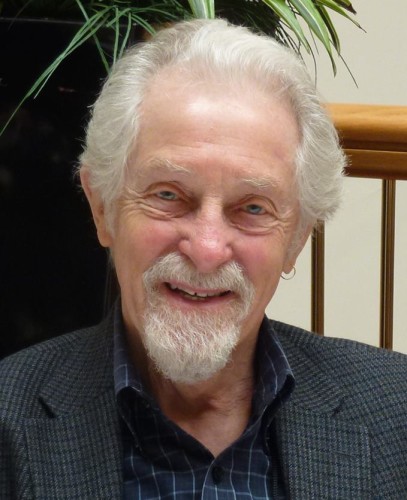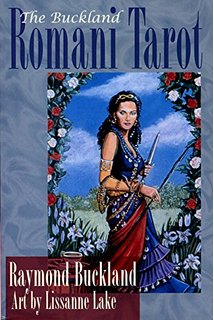OHIO — Raymond Buckland is known in Pagan circles as the man who brought Gardnerian Wicca to the United States of America. His name graces the cover of more than 40 books on Pagan and occult topics, published over the last 47 years. That history is more than enough to cover in the course of just one interview, but despite his prolific writing and years of teaching, Buckland has also found time to keep busy with quite a number of non-Pagan activities. These activities are wide-ranging and include, in his own words, “acting and the theatre, music (jazz, ragtime, bluegrass, etc.), art (illustrating books, cards, filmstrips, etc.), comedy (both writing and performing), ultralight flying, sports cars, screen-writing, all types of writing, especially fiction and non-fiction,” not to mention occasional stints of stand-up comedy.
 Given the vast number of things that continue to keep Buckland’s days full, narrowing the scope of conversation to just his Pagan activities seemed, at the very least, to be a kindness to the reader. Indeed, the fact that he was able to respond to questions at all suggests that some powerful time-bending magic might be at work. Even so, the interview was conducted via email over several months.
Given the vast number of things that continue to keep Buckland’s days full, narrowing the scope of conversation to just his Pagan activities seemed, at the very least, to be a kindness to the reader. Indeed, the fact that he was able to respond to questions at all suggests that some powerful time-bending magic might be at work. Even so, the interview was conducted via email over several months.
The Wild Hunt: What’s occupying your time recently? Any upcoming or recent projects you’d like to talk about?
Raymond Buckland: My time these days is mostly taken up with writing mysteries, especially Victorian mysteries. I have done a series (the Bram Stoker Mysteries) for Penguin/Random House’s Berkley Prime Crime and am now working on two other series: The Postmistress Mysteries and the Designing Women Mysteries, both set in England in the 1800s.
In addition I also organize, and take part in, a twice-yearly comedy night locally and also run a weekly writers’ guild.
TWH: The scope of Paganism has changed a lot since you wrote your first book. Right now, what kind of Pagan would you call yourself? Is Seax-Wica still part of your spiritual identity?
RB: Seax-Wica is definitely still part of my spiritual identity. I don’t care much for labels -– though some do seem necessary –- so will not label myself. I am very much a solitary practitioner these days and draw on a variety of beliefs and practices. When I moved to Ohio from California, back in 1992, I became a solitary and have remained so ever since.
TWH: Of all your published works, which one is your favorite? Why?
RB: I have one or two favorites. I suppose that’s natural, having written so many books! In non-fiction I would have to list “Buckland’s Complete Book of Witchcraft,” “Buckland’s Book of Spirit Communication,” the three encyclopedias: “The “Witch Book,” “The Fortunetelling Book” and “The Spirit Book,” plus two of my decks: “The Buckland Romani Tarot” and “The Cards of Alchemy.”
With fiction then it would be the stand-alone: “Golden Illuminati” and the Bram Stoker series.
 TWH: Thinking back to the time of your initiation in 1964, what’s the most surprising development you’ve seen among Pagan religions in the time since?
TWH: Thinking back to the time of your initiation in 1964, what’s the most surprising development you’ve seen among Pagan religions in the time since?
Be it Wicca or Paganism generally, the most surprising development is the very development itself; the growth of the movement. I had always hoped that we would reach the point where Wicca was generally accepted as “just another religion” and in many respects that has been achieved.
TWH: How do you think coverage of Pagans in the news has changed since the 1960s?
RB: It has changed dramatically. No longer are such news items included simply because they seem unusual (“Strange and odd-ball” even) but are being included because the events actually are news.
TWH: I have conflicting sources about the name of the first coven you had in the United States. Without vanguard like that?
Back in those days we didn’t name our covens, probably because there just weren’t enough of them. The first American coven met initially in Floral Park, Long Island, and then shortly after moved to Timberline Drive, Brentwood, Long Island, New York. It was simply “The Covenstead,” which is the name given to any home of a coven. Later, as more covens were established, then it became regarded as the New York covenstead, but we never gave it an actual name per se.
What it was like being at the vanguard was . . . tiring! Of course, we didn’t realize that we were at the vanguard of anything, though we were certainly trying to spread the word and by doing so to establish the Craft here in this country, which was what Gerald (Gardner) asked me to do.
TWH: Do you have a story you can share about your relationship with Gerald Gardner?
RB: Gerald was very keen to get the Craft established here in America and did rather push that. His greeting was never, “How are you?” but rather right into, “We have got to get you going over there.” He was wonderful in that Witchcraft (only later called Wicca) was his whole life and focus. He was extremely dedicated and there was no question about his sincerity. I tried hard to pattern myself on him and, in fact, found so many things in my life following his. There have been rumors that I changed things in his Book of Shadows when in New York. That is totally untrue (though I know that our successors on Long Island made many, many such alterations). I made it a practice to follow Gerald’s teachings and Book of Shadows to the letter.
TWH: When did you first start noticing differences between British and American forms of Wicca?
RB: I guess that as people began to realize that the Craft was now (then) getting going in America they started actively looking for differences. So far as Gardnerian was concerned, as much as I was able in the beginning, I tried hard to stick to what I had been taught. Later, when the baton was passed on to Theos and Phoenix, there were a LOT of changes made by them (to my chagrin, many of those have been erroneously attributed to me), so these were very much brought home to me.
In my autobiography (still working on it) I make the observation that, in my opinion, Theos and Phoenix probably did more harm to Witchcraft than did the whole of the Christian persecutors back in the Middle Ages! But apart from all that, over the years there have been many gradual and natural changes brought in. I certainly have no problem seeing “new” versions and variations of the Craft developing (after all, I did start Seax-Wica), but I would like to see Gardnerian remain as it was originally.
![[Video Still from 2016 Comedy Performance]](https://wildhunt.org/wp-content/uploads/2016/06/Presentation1.jpg)
[Video Still from 2015 Comedy Performance]
RB: Yes, I had a bit of a set-back last year, in July. I developed a bad case of pneumonia which brought on a heart attack, leading me to being life-flighted to a hospital. I was on a ventilator for a very long time (several days) and ended up greatly debilitated. Ever since I have been making the long crawl back to health through physical therapy. But, at 81 (82 in August) I am now walking two miles every morning and spending an hour on exercises every afternoon. I no longer will travel any great distances, don’t do public appearances, and keep pretty low key with my writing (all fiction these days). But on the bright side, I feel so much better and am keeping very active locally, though not in any way pagan-oriented.
TWH: Have you given any thought to your legacy, and what you’d like to be remembered for in fifty or a hundred years, or more?
RB: The museum which I founded back in the 1960s has recently been taken over by fresh blood who are working on restoring and up-dating it, so that will be re-established. My personal library I have donated to someone who is going to be establishing the Raymond Buckland Memorial Reference Library, which will be in Kentucky. Many of the books I have authored are still in print. So all-in-all I think I’m leaving something. How much value that all is, I don’t know!
I guess I’d like to be remembered as someone who did his best to expand Gardnerian from the UK to the US, who tried to write truthfully about the Craft (without ever breaking his original oath of secrecy) and as someone who very much enjoyed working with others in many different fields.
As to when I die (though I keep assuring my wife that I’m not actually going to go!) I will be cremated and everything is in hand for that eventuality.
* * *
The Wild Hunt will update readers on the progress and opening of both the Raymond Buckland Memorial Reference Library and the Raymond Buckland Museum. Buckland’s fiction work and other writings can be found on his website Raymond Buckland Books. He has uploaded videos of his stand-up comedy, theatrical and musical work to his YouTube channel.
Note: The Wild Hunt would like to thank Rev. Selena Fox for making this interview possible.
The Wild Hunt is not responsible for links to external content.
To join a conversation on this post:
Visit our The Wild Hunt subreddit! Point your favorite browser to https://www.reddit.com/r/The_Wild_Hunt_News/, then click “JOIN”. Make sure to click the bell, too, to be notified of new articles posted to our subreddit.
Interesting interview! So glad to see the stories of some of our elders being documented.
Many of us know nothing of Theos and Phoenix; what did they do that so harmed the Craft, in Ray’s opinion (or yours)?
Minor correction of date. Ray’s initiation took place (in Perth, Scotland) in mid-November 1963, with GBG in attendance as Monique (Nikki) Wilson & her husband Scott officiating. It was the last initiation (as far as we know) at which Gardner was present, given that he began his annual winter cruise to warmer climes within a week or so (before Thanksgiving).
Pretty cool to have interviewed such an important figure! Many interesting bits of info there too!
Pingback: Entretien avec Raymond Buckland, Pionnier américain de la Wicca-Wildhunt | une simple étoile
I briefly stopped into the Witch’s Mill twice in 1968. I briefly met Monique Wilson as I entered and paid the entrance fee. The second time that I was there I did ask where I might get some the jewelry made like she was wearing. I recall that both times I was the only customer in the museum at the height of the tourist season in the Isle of Mann. Considering the great controversy over her later selling the collection, I got the impression that the Museum was doing rather poorly. Unlike the present museum in Boscastle, which had much aid after the flood, I don’t think there was such help available back then.